Easter is an odd holiday. While it has admittedly deep religious significance for Christians, for the rest of the world (and for Christians too), Easter mashes together a very weird pastiche of cultural iconography, presumably all about the celebration of “Spring.” Easter is a holiday symbolized by bunnies who deliver eggs (as opposed to chickens who are normally responsible for egg production), cute little chicks that apparently came from eggs that escaped the bunnies’ dye factories, a metric ton of candy, and really, really big hats. I’m not entirely sure how that all comes together to celebrate the Spring Equinox, but, like most major holidays, it’s just weird enough to work. I don’t understand Easter, but I like it and I really enjoy sharing it with my daughter.
And one of the best ways I’ve found to share Easter with my daughter is reading her The Country Bunny and the Little Gold Shoes by Du Bose Heyward and Marjorie Flack, a book that I regard as THE definitive Easter book for kids. You can find many Easter-themed books at the bookstore, just begging to be tucked into that weird fake grass in your child’s Easter basket, but, trust me, no book has ever done a better job of creating a more enchanting and engrossing mythology around Easter than The Country Bunny and the Little Gold Shoes.
Originally published in 1939, The Country Bunny and the Little Gold Shoes was actually authored by Du Bose Heyward, the author best known for writing the novel Porgy, which was the basis for George Gershwin’s opera Porgy and Bess. Heyward originally composed the story simply to entertain his nine-year-old daughter Jenifer – the book’s subtitle is “as told to Jenifer” – until Marjorie Flack, a noted illustrator, asked him to collaborate with her into turning The Country Bunny into a children’s book.
(If you want a much more detailed and beautifully written account of the book’s origins, check out the entry on The Country Bunny and the Little Gold Shoes on Anita Silvey’s wonderful Book-a-Day Almanac.)
So, what’s so special about this seventy-four-year-old picture book? For starters, it creates one of the most coherent mythologies around Easter that I’ve ever read. As the book opens, Heyward explains to us:
We hear of the Easter Bunny who comes each Easter Day before sunrise to bring eggs for boys and girls, so we think there is only one. But this is not so. There are really five Easter Bunnies, and they must be the five kindest, and swiftest, and wisest bunnies in the whole wide world, because between sunset on Easter Eve and dawn on Easter Morning they do more work than most rabbits do in a whole year.
In The Country Bunny and the Little Gold Shoes, Heyward transforms the Easter Bunny into a shared role held by five different rabbits of varying shapes and sizes, which, as a parent, I think is fairly genius. Particularly because, around Easter time, kids are barraged with Easter Bunny meet-and-greet opportunities and the colors and sizes of those Easter Bunny costumes vary WILDLY. But, thanks to The Country Bunny, when my daughter asks me why the Easter Bunny at the mall was white and the Easter Bunny at the grocery store was brown, I can just say, “Hey, remember The Country Bunny? There are five all together, so…” (I realize that Heyward probably wasn’t thinking about furry character photo ops when he wrote the book, but, hey, it works for me.)
After Heyward establishes the mythology of the Easter Bunny role – the wise old Grandfather Bunny selects the five best bunnies in the world to serve every Easter – he then introduces us to his heroine, the thoroughly modern Cottontail, also known as The Country Bunny. Cottontail aspired to be one of the Easter Bunnies as a child, but she was routinely mocked by “the big white bunnies who lived in fine houses” and “the Jack Rabbits with long legs” who told the poor girl to (and I quote) “go back to the country and eat a carrot.” (Ouch.)
Cottontail grew up, found a husband (who never actually appears in Heyward’s tale), and had twenty-one Cottontail babies, which made the big white bunnies and Jack Rabbits mock her dream of becoming an Easter Bunny even more. However, one day, when her children were old enough, Cottontail looked at her children and said, “Now we are going to have some fun.” And, remarkably, through her cleverness and patience and kindness, Cottontail teaches her children to be amazingly self-reliant. Each child is assigned a job – some cook, some clean, some garden – and they all work together to build a happy home.
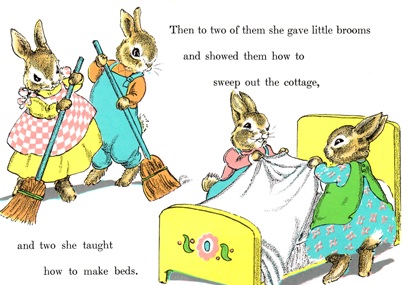
I guess, when you have an unlimited supply of chocolate and jelly beans, training your kids is pretty easy…
When Grandfather Bunny announces that he’s looking for a new Easter Bunny, Cottontail takes her children to watch the selection process. After all the fancy, long-legged bunnies show off their stuff, Grandfather Bunny’s eyes fall on Cottontail and he eventually realizes that she’s the perfect candidate for the job. (She has to be swift to care for all her children, her kindness is reflected in what a warm home she’s built, she’s obviously clever for teaching her kids to be so self-reliant, etc.) So, the single mom who was mocked by all of the more “respectable” bunnies becomes one of only FIVE Easter Bunnies in the whole world. In the rest of The Country Bunny and the Little Gold Shoes, Heyward crafts the dramatic tale of Cottontail’s first Easter on the job, particularly her travails trying to deliver one final egg to a deserving child before the sun comes up. (Spoiler alert – A pair of magic little gold shoes might come into play.)
Why is The Country Bunny and the Little Gold Shoes such an fantastic Easter book? There are many reasons. For starters, it is a remarkably feminist take on the Easter Bunny legend, particularly for having been published in 1939. Cottontail is constantly mocked for her Easter Bunny aspirations and, after she decides to have a big family full of children, the white rabbits and Jack Rabbits mock her even further, telling her, “Only a country rabbit would go and have all those babies. Now take care of them and leave Easter eggs to great big men bunnies like us.” (Oh no, they didn’t…) So, the fact that, later in the story (not to give anything away), Cottontail becomes one of the most beloved and accomplished Easter Bunnies of all time, it really transforms Cottontail into a fantastically empowering female literary hero.
One of the other reasons why I like The Country Bunny and the Little Gold Shoes so much is that it really humanizes the role of the Easter Bunny in a way that most other holiday icons lack. In Heyward‘s vision, the Easter Bunny is an aspirational role. It’s a job that bunnies earn through hard work, compassion, intelligence, and perseverance. Can the same be said about Santa Claus or the Tooth Fairy? Those aren’t jobs that those holiday icons earned – as far as we know, Santa, the Tooth Fairy, and Cupid have had their positions of holiday prestige forever. But, thanks to The Country Bunny and the Little Gold Shoes, my daughter now views the Easter Bunny as an ever-changing position that is awarded to special bunnies based on their levels of empathy and skill, which gives that role exponentially more depth than a guy in a rabbit suit at the mall ever could.
Yes, Easter is an odd holiday and, if asked, I really can’t explain why we celebrate Spring with a bunny delivering painted eggs and jelly beans. (Be honest – it’s a very weird mish-mash of images.) But, thankfully, with The Country Bunny and the Little Gold Shoes, Du Bose Heyward created an amazing work of cultural mythology, which is the most engaging and accessible legend of the Easter Bunny that I’ve ever read. It’s a book that not only makes it easier to share Easter with my daughter, but it makes me excited to do so. I know Easter is coming up fast, but, if you can grab a copy of The Country Bunny and the Little Gold Shoes to stuff in your kid’s Easter basket this year, you won’t regret it.
THE DETAILS ON THE COUNTRY BUNNY AND THE LITTLE GOLD SHOES:
AGE RANGE: The stated reading level is 4-8 years – it’s a fairly text-heavy picture book that might be a challenge for some first-graders – but the subject matter is extremely gentle and perfect for sharing with younger children.
PAGE COUNT: 45 pages
WEB SITES: Not surprisingly, Du Bose Heyward isn’t on Twitter, but you can find a few really great overviews of The Country Bunny and the Little Gold Shoes here and here and here.
BUY IT, BORROW IT, OR FORGET IT?: I think it’s a pretty essential book and one of the only Easter books worth owning, so I’d say buy it.
IF YOU LIKED THE COUNTRY BUNNY AND THE LITTLE GOLD SHOES, YOU MIGHT ALSO LIKE:
- Runny Babbit: A Billy Sook by Shel Silverstein – This might seem like an odd choice – there’s nothing particularly Easter-themed about this posthumous collection of poems from the great Shel Silverstein – but it’s a hilarious work of nonsense with a very silly rabbit as the title character and I’ve seen it given as an Easter present before, much to the great delight of the kid receiving it. It’s hard to explain why rabbits are the perennial symbol of Easter anyway, so why not celebrate the holiday with one of the funniest rabbit books around?
- The Easter Egg by Jan Brett – This is a gorgeous (and very sweet) take on the holiday tradition of painting Easter eggs. In Brett’s picture book, a young bunny, eager to paint Easter eggs like all of his bunny friends, finds himself stuck as the guardian for a wayward robin’s egg. It’s not as profound as The Country Bunny and the Little Gold Shoes, but it’s beautiful, heartfelt, and much, much better than most of the “It’s a SpongeBob Easter!” books you’ll find at Target this time of year.
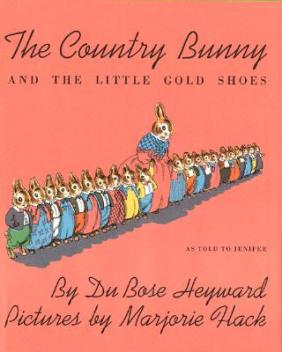
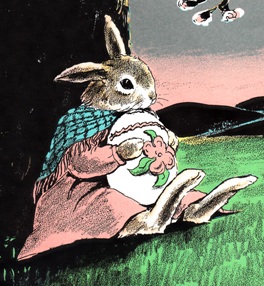
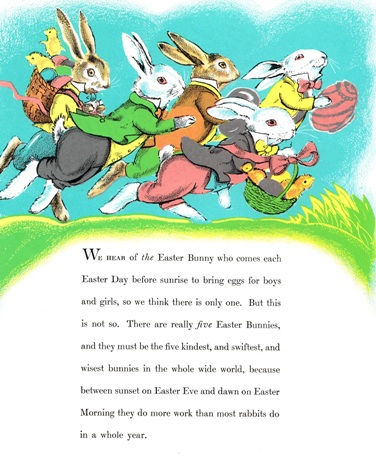
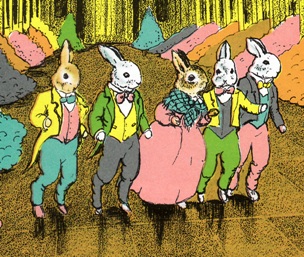
{ 7 comments… read them below or add one }
I read this story over and over, as a child, from the Junior Classics Harvest of Holidays book. I bought the modern version for my classroom when I was teaching, and also read it to my sons every Easter. Thank you for your great review of it. It really deserves such high praise. She has stuck with me all these years, and I’m currently sculpting her likemess in a doll, because I love her so much!
I grew up and had the hard back, it got destroyed in a flood..so I lost the great printing and pics but thank goodness I was able to find soft copies. My kids adore this book as well as my grandkids.
i couldnt remember the title of this book… have always wanted to get it for my kids, even though they are too old now, still think its a beautiful book and even adults can enjoy it.
Thanks for introducting this great Easter story to others. I purchased this book for my adult daughter when she was a little girl. She still treasures the book and has purchased it for her four year old niece, who loves books and storytime.
Wow, I had completely forgotten about that book! I don’t remember who gave it to me, and usually thought of it as “the rabbit book I have that’s *not* The Velveteen Rabbit.” Like you said, the density of text and length kept me from reading it to myself for a few years. I remember enjoying it quite a bit, though, once I did read it.
One thing I would note, is when you order from Amazon, there are two options, a larger-size picture book which I think is the originial size, and also a much smaller sized book which comes with a golden shoes charm.
I’ve bough the latter by mistake, and while I’ve been disappointed (I think the larger boook is nicer) the girls I’ve given the books to have loved the charm.
That’s a fantastic bit of advice – thanks for sharing it! We have an older paperback copy that my wife has had for years, which I think is the original size. But I never knew about the edition that comes with the charm. Hmm… I’m half-tempted to seek it out for my daughter’s Easter basket now.
You must log in to post a comment.